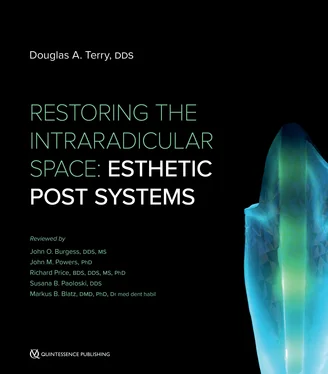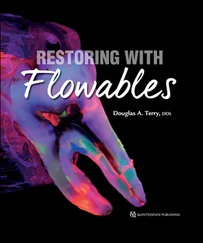Traditional prefabricated metal posts are made of platinum-gold-palladium, brass, nickel-chromium (stainless steel), pure titanium, titanium alloys, and chromium alloys. 7 , 37 – 39 ,164 Although stainless steel is stronger, the potential for adverse tissue responses to the nickel has resulted in the use of a biocompatible titanium alloy.189 ,190 Also, contributing factors to root fracture such as excessive stiffness (modulus of elasticity)191 –193 and post corrosion 7 ,121 ( Fig 1-3) from many of these metal posts have generated concerns about their use. In addition, prefabricated metal posts can negatively affect the esthetic result.
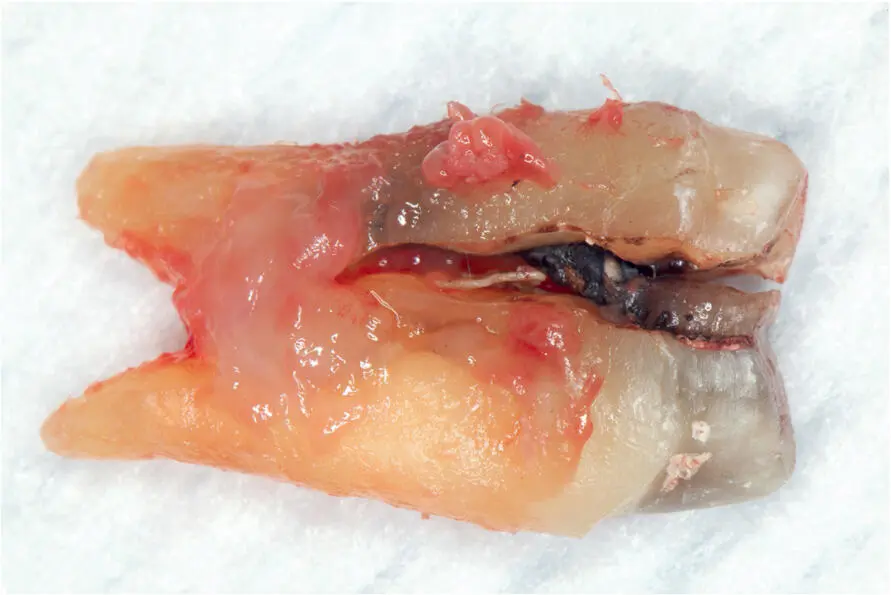
Fig 1-3 Posts and cores fabricated from materials with a high modulus of elasticity and a combination of noble and non-noble alloys in the oral environment may result in electrochemical reactions such as corrosion of metals, which can cause root fracture.
Nonmetallic prefabricated posts have been developed as alternatives,194 including ceramic (white zirconia) posts, carbon-fiber posts, and fiber-reinforced resin posts. Zirconia posts have a high flexural strength and are biocompatible as well as corrosion resistant.195 This material, however, is difficult to section intraorally with a diamond bur and difficult to remove from the canal for retreatment.164 Carbon-fiber posts are made from unidirectional carbon fibers held together with an epoxy resin and ceramic. They exhibit strength and relatively high flexibility and can be retrieved from the canal preparation with ease for retreatment. However, their black color has a negative effect on the final esthetic result of all-ceramic crowns.189 New advances with next-generation tooth-colored posts, which are identical in design to conventional carbon-fiber posts, reduce this esthetic challenge. There are several methods for the fabrication of the direct fiber-reinforced resin system that include a bondable polyethylene woven reinforcement fiber (Ribbond-THM, Ribbond; Construct, Kerr/Sybron), a prefabricated fiber-reinforced composite post system, a direct anatomical formed fiber-reinforced composite post system, 105 ,195 ,196 a direct/indirect anatomical formed fiber-reinforced composite post system, and an indirect anatomical formed fiber-reinforced composite post system (see the section entitled “Direct Fiber-Reinforced Post and Core System” later in this chapter).
CONSIDERATIONS FOR THE SELECTION OF RESTORATIVE MATERIALS
As the clinician continues the search for optimal functional and esthetic success with a post-retained crown system, the current selection of restorative materials and techniques may prove overwhelming. While no single system provides the ideal restorative solution for every clinical circumstance, understanding both general design criteria and the components for the various post and core systems available allows the clinician to appropriately select the method and materials compatible with the existing tooth structure and desired result. A system is defined as any set of components working together for the overall objective of the whole. 1Selecting the proper post and core system for a specific clinical situation requires an evaluation of the various components and interfaces of the system.197 ,198 The components of the direct fiber-reinforced composite resin post system are the surface of the root dentin, the intraradicular post, the core buildup, the luting cement, and the final restoration199 ( Fig 1-4). The system can be analyzed in four regions: (1) at the intraradicular surface (dentin surface), (2) at the post-tooth interface, (3) within the core, and (4) intracoronally. For the successful rehabilitation of the ETT, it is imperative to understand the disparity and complexity of the interrelationship of these interfaces with various restorative materials. 55The failures of each system provide us with design principles that can be utilized with any post-retained crown system. These specific design principles bring us to higher levels of understanding potential problem areas in any restorative situation. Therefore, the following design principles should be considered when using any post-retained crown system. An evaluation of the direct fiber-reinforced resin post system with these design principles is provided.
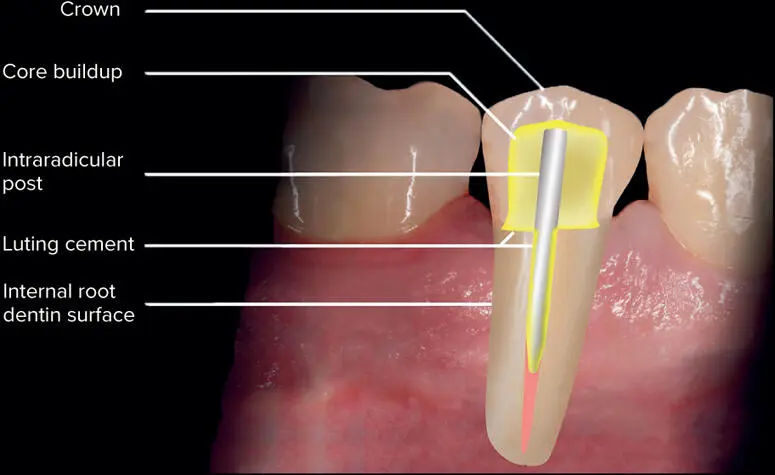
Fig 1-4 The five components of the post-retained crown system are the internal root dentin surface, luting cement, intraradicular post, core buildup, and the crown. The system can be analyzed at each of the four interfaces: at the dentin surface, at the post-tooth interface, within the core, and intracoronally.
Maximum post retention and core stability
Dislodgment and tooth fracture are causes for failure of post and core restorations. The majority of clinical failures involving fiber-reinforced post systems occur through debonding. 15 , 29 , 45 , 80 , 100 ,119 ,120 ,124 –126 ,200 –215 Core stability and post retention are important in preventing these failures in the restoration of ETT 51 , 105 ,164 ,166 ,168 ,177 ,193 ,216 –218 ( Fig 1-5). The ideal post system should replace lost tooth structure while providing adequate retention and resistance for the core and final restoration while transferring occlusal forces during function and parafunction to prevent root fracture. Adhesive post systems allow conservative minimally invasive preparations that preserve sound tooth structure and strengthen the remaining tooth. However, meticulous adhesive protocols are required for reliable bonding and effective adhesion. Improving the quality of the adhesive interface and the long-term adhesion of fiber-reinforced post systems to dentin requires improving resin impregnation into dentin,212 ,219 –227 enhancing the strength of the polymer formed by the adhesive system,212 ,228 –252 and increasing the resistance of collagen fibrils to enzymatic degradation.212 ,253 –273 Because the root canal anatomy can impose limitations to achieving a quality hybrid layer, modified clinical protocols have been suggested. Studies indicate that various methods and materials can improve the stability of the resin-dentin bond.
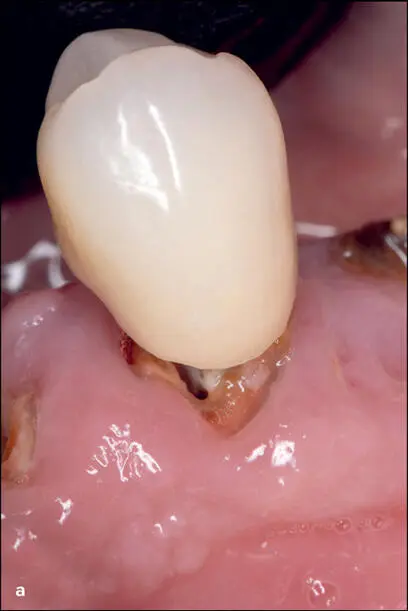
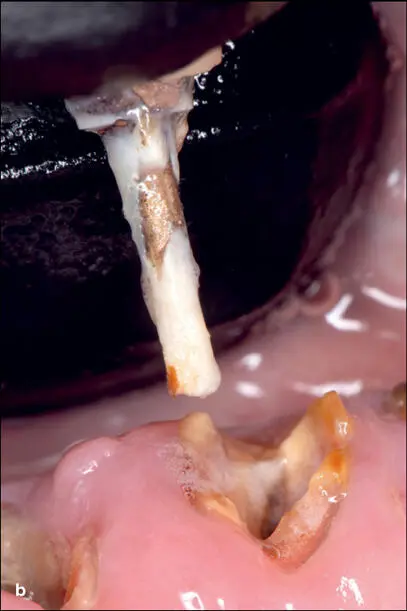
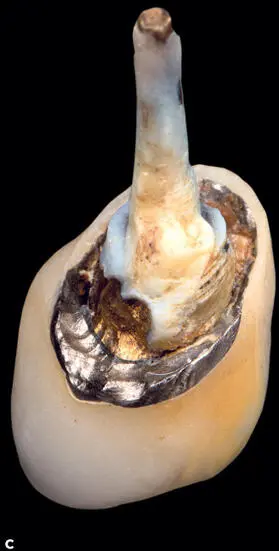
Fig 1-5 (a to c) Failure of a post-retained system. The metal-ceramic crown with gold post dislodges form the intraradicular space as a result of microleakage and recurrent caries at the interface.
Numerous studies suggest methods and materials to improve resin impregnation into dentin. One study indicates that diamond bur preparation of the post channel in comparison to a carbide bur allows the etching procedure to remove the smear layer more efficiently with more open dentinal tubules and with fewer smear layer remnants. Thus, the acid-resistant smear layer produced by the manufacturer’s carbide bur for post space preparation can be removed with a similar-diameter diamond bur, and the replaced smear layer will be more susceptible to phosphoric acid dissolution.212 ,220 Other studies indicate that liquid phosphoric acid applied with an endodontic needle improved the removal of the smear layer better than gel etchants and that higher bond strengths to the dentin were achieved when an etch-and-rinse adhesive system was utilized.212 ,226 ,227 Several studies indicate that vigorous rubbing of the adhesive may improve the permeability of the etchant into the dentin collagen network.223 ,224 Other studies indicate that the application of multiple layers of simplified etch-and-rinse adhesives and self-etch adhesives to coronal dentin yield higher immediate bond strengths.221 ,222 However, this modified protocol should be applied with caution to prevent post seating because of the increase in thickness of the hybrid layer. It is suggested that paper points or a vacuum capillary tip adapter (Luer Vacuum Adapter, Ultradent) can be utilized to absorb the excess solvent.212
Читать дальше
